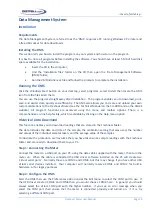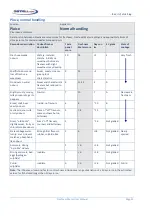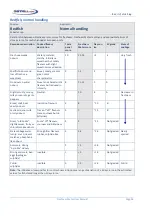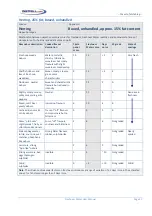
...the
art
of
distell
‐
ing...
Freshness
Meter
User
Manual
Page
28
Haddock
&
Whiting,
normal
handling
Species:
Haddock
&
Whiting
Melanogrammus
aeglefinus,
Merlangius
merlangus
Applies
to:
Normal
handling
Relationship
between
objective
sensory
scores
for
freshness,
Freshness
Meter
readings,
and
approximate
times
of
storage
in
ice,
for
haddock
&
whiting
landed
at
European
ports
Raw
odour
description
Cooked
flavour
description
Taste
panel
score
Freshness
Meter
score
Days
on
ice
EC
grade
State
of
spoilage
Fresh
sea
‐
weedy
odours
Watery,
metallic,
starchy.
Initially
no
sweetness
but
meaty
flavours
with
slight
sweetness
may
develop
10
16
<
2
E
Very
fresh
Shellfish
odours
and
loss
of
fresh
sea
‐
weediness
Sweet,
meaty,
creamy,
green
plant
characteristics
9
15
<
2
E
No
odours,
neutral
odours
Sweet
and
characteristic
flavours
but
reduced
in
intensity
8
11
‐
12
4
A
Slightly
musty,
mousy,
milky
or
caprylic,
garlic,
peppery
Neutral
7
8
7
A
Decrease
in
freshness
Bread,
malt,
beer,
yeasty
odours
Insipid,
no
flavours
6
7
~
10
B
Lactic
acid,
sour
milk,
or
oily
odours
Trace
of
“off”
flavours,
some
sourness
but
no
bitterness
5
3
‐
4
~
13
B
Grass,
“old
boots”,
slightly
sweet,
fruity
or
chloroform
‐
like
odours
Some
“off”
flavours,
sourness
and
bitterness
4
<
3
~
15
Not
graded
Stale
cabbage
water,
turnip,
sour
sink,
wet
matches,
phosphene
‐
like
odours
Strong
bitter
flavours,
rubber,
sulphide
‐
like
3
<
3
~
18
Not
graded
Nearly
spoiled
Ammonia,
strong
“byre
‐
like”
odours
2
<
3
>
18
Not
graded
Strong
ammonia,
bad
eggs
(hydrogen
sulphide)
Inedible
1
<
3
>
18
Not
graded
Putrid,
sulphides
Inedible
0
<
3
>
18
Not
graded
Putrid
Note
:
The
influence
of
seasonal
factors
on
freshness
introduces
a
range
of
variation
of
±
2
days
in
ice
in
the
estimated
values,
for
fish
stored
longer
than
2
days
in
ice.
















































